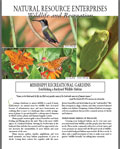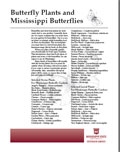Game Animals
Non-game Animals
Habitat
Hummingbirds and Butterflies
- Provide a variety of flowering plants and shrubs with overlapping blooming seasons
- Artificial feeders must be regularly cleaned and maintained
- Specific host plants for butterfly larvae are important
- Hummingbirds and butterflies are pollinators
Species Description: Hummingbirds
There are about 16 species of hummingbirds in North America and 10 of them have been seen in Mississippi. The most commonly found species in Mississippi and the rest of the country is the ruby-throated hummingbird.
All hummingbirds are very small and have high metabolisms. Much of their energy is spent flying, so they consume up to twice their body weight in nectar every day. About 150 plant species are pollinated by hummingbirds, so many people like to attract these birds to their gardens. Hummingbirds also feed on insects such as mosquitoes, fruit flies, small bees, and aphids.
Hummingbirds prefer a habitat with a diversity of flowers and shrubs. Flowers and shrubs with overlapping blooming seasons can provide year-round nectar sources. Regularly maintained artificial feeders also can provide hummingbirds with a steady supply of nectar.
Species Description: Butterflies
From egg to adult, butterflies undergo a series of physical transformations known as metamorphosis. They start out as caterpillars, or larva, hatched from tiny eggs laid on host plants. Eventually, the caterpillars shed their skins several times before moving into the pupa stage. Then, in just a few weeks, an adult butterfly emerges.
Many people enjoy having butterflies in their gardens and can easily create habitats to attract them to their landscapes. Habitats should include areas with plenty of sunlight so the butterflies can easily absorb enough heat to maintain appropriate body temperatures. They also need densely vegetated areas for night shelter and protection from inclement weather.
Butterflies need host plants to lay eggs on and eat during the caterpillar stage, and nectar plants to feed on as adults. These plants include everything from Queen Anne’s lace, purple cone flowers and marigolds to azaleas, abelia and cherry trees.
Videos
Hummingbirds
Rabbit Habitat
Partridge Pea
Wetland Plants

Mississippi Recreational Gardens: Establishing a Backyard Wildlife Habitat (PDF)
Mississippi State University Extension Service, Natural Resource Enterprises Program
All wildlife requires food, water and shelter to survive. This publication discusses providing those necessities in a backyard environment. Detailed information is given on how to attract birds, hummingbirds, butterflies, bats, snakes, lizards, toads and frogs. Information is also provided on controlling deer, rodents, and other animals that are considered pests. Management tips are given for making your backyard the best habitat possible including an example and how to create a trail.

Butterfly Plants and Mississippi Butterflies (PDF)
Mississippi State University Extension Service
Butterfly gardens must have two types of plants: host plans for larvae and nectar plants for adults. This paper presents a list of the common butterflies of Mississippi, host plants, and nectar plants to put in your garden.
Attracting Butterflies to Your Yard (PDF)
Purdue University Forestry and Natural Resources
Attracting butterflies to your yard involves providing food plants for adults and larvae and cover. This publication discusses creating butterfly habitat and tips for attracting butterflies.

